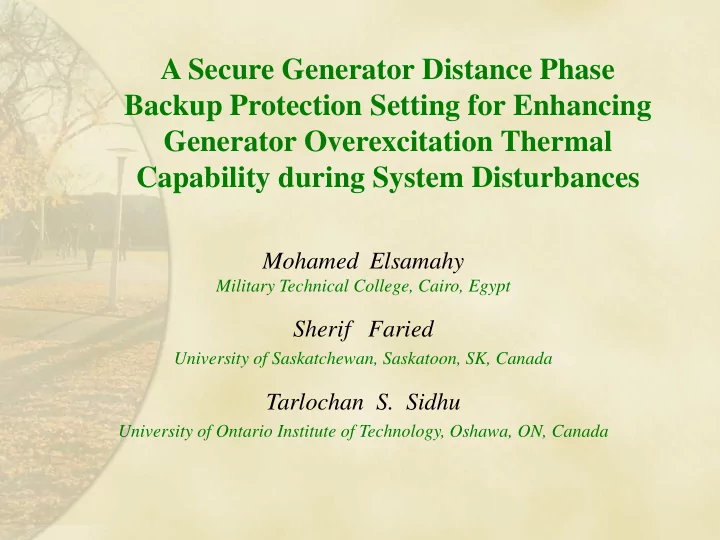

A Secure Generator Distance Phase Backup Protection Setting for Enhancing Generator Overexcitation Thermal Capability during System Disturbances Mohamed Elsamahy Military Technical College, Cairo, Egypt Sherif Faried University of Saskatchewan, Saskatoon, SK, Canada Tarlochan S. Sidhu University of Ontario Institute of Technology, Oshawa, ON, Canada
Contents Motivation Steady State Generator Overexcited Capability (GOEC) Generator Distance Phase Backup Protection (Relay 21) Coordination between Relay 21 and GOEC Overexcitation thermal capability and Overexcitation limiter (OEL) System Under Study and Simulation Results Conclusions 2
Motivation “Performance of generation protection during major system disturbances” • Due to generator protection misoperations during recent blackouts : 1996 outages in the Western U.S. 2003 U.S. East Coast blackout 2007 Saskatchewan mid west disturbance As a result the need for better coordination of generator protection with generator capability and control has come to light. • Therefore, NERC has mandated several tests and is asking users to verify the coordination between generator protection and control. 3
Generator Capability Curve (GCC): Armature current limit (2) Field current limit (1) Stator end core limit (3) 4
Generator Capability Curve (GCC): Q MVAR into System A Field Limit Overexcited B GOEC Stator Limit MW into System P C Gas Stator End Underexcited GUEC Core Limit D E Steam Hydro MVAR into generator F GOEC: Generator overexcited capability 5 GUEC: Generator underexcited capability
Generator distance phase backup protection (Relay 21) A- Condition of operation: - Within generator capability limits. -It detects system phase faults external to generator zone. Impedance C.B plane Transmission system Main C.B Block zone Trip zone 21 Generator Zone Relay Characteristic Relay connection B- Mode of operation: -Always monitoring. - Delay time from the fault occurrence to trip the unit out of service. 6
Generator distance phase backup protection (Relay 21) (cont.) C- Setting criteria: • 120% of the longest line with in-feeds. • 50 to 67% of the generator load impedance (Z load ) at the rated power factor angle (RPFA) of the generator. • 80 to 90% of the generator load impedance at the maximum torque angle (MTA) of the relay setting (typically 85) (Z GCC ). • A proper time delay for the relay should be set with appropriate margin for proper coordination with transmission lines backup protection. 7
Coordination between Relay 21 and GOEC MVA GOEC β Transformation of P-Q to R-X plot 8
Generator overexcitation thermal capability In response to system voltage drops caused by high reactive power requirements, switching manipulations or faults, the generator field winding is allowed for short time overexcitation levels . IEEE/ANSI C50.13 9
Generator Overexcitation limiters (OEL) OEL operation during a system disturbance. 10
System Under Study B A 230 kV, 300 km ∞ G 21 Hydro Infinite Generator Bus Different cases are considered: (fault location, fault type, and generator loading) 11
Coordination between Relay 21 and GOEC for the generator under study • PPFA: Rated Power Factor Angle (19.95 0 ) • MTA: Maximum Torque Angle (85 0 ) • Z 21 : Relay 21 characteristic (23.25 Ω at 85 0 ) • Z GCC : Maximum permissible limit (25.955 Ω at 85 0 ) • Time delay of 2 second is considered 12
Disturbance 1, OEL response Generator terminal voltage and field current transient time responses as well as Relay (21) trip signal during and after Disturbance 1. 13
Disturbance 1, Relay 21 Impedance measured by Relay 21 during and after Disturbance 1 14
Disturbance 2, OEL response Field current transient time response as well as Relay (21) trip signal during and after Disturbance 2. 15
Disturbance 2, Relay 21 Impedance measured by Relay 21 during and after Disturbance 2 16
Impedance measured by Relay 21 with reduced setting during and after Disturbances 1, 2 17
Conclusions • The current setting of Relay (21) for generator thermal backup protection restricts the overexcitation thermal capability of the generator • Such a restriction does not allow the generator to supply its maximum reactive power during system disturbances. • The paper highlights the need for revising the setting of the Relay (21) through in-depth dynamic stability studies in order to allow the generator to fulfill the system requirements during major disturbances to ensure adequate level of voltage stability • In this regard, the paper proposes the reduction of Relay (21) reach 18
THANK YOU For further information, please contact Dr. Mohamed Elsamahy, P.Eng. Department of Electrical Power & Energy Military Technical College, Cairo, Egypt mohamed.elsamahy@usask.ca mohamed.elsamahy@ieee.com 19
Recommend
More recommend